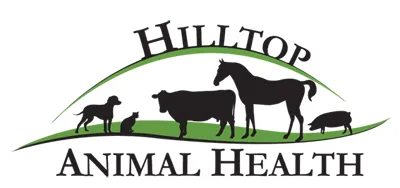“Chew on This”
Dental Health Care
Cade B. Coppenbarger DVM
Monika Payne, DVM
Hilltop Animal Health P.C.
In the last few years much attention has been focused on veterinary dentistry. Research clearly show that proper dental care is one of the most important things you can do to add length of years and a higher quality of life for your pets. Approximately 85-95% of all dogs and cats two years old or older have periodontal disease. The first sign of periodontal disease is halitosis (bad breath). Periodontal disease is the major cause of tooth loss in your pets and is also a major factor in infections of the liver, heart, lungs, and kidneys. When the gums become inflamed it is painful. Dogs and cats have the same nerve supply to their teeth and gums as humans do. Red gums indicate inflammation/infection and can really be harmful to your pet’s health. Plaque begins to accumulate 24-48 hours after eating and begins to mineralize into calculus and tarter. As this infection builds up the bacteria spreads under the gum line. This is where the real damage occurs. The gum begins to separate from the tooth as the disease progresses.
Cleaning our own teeth is something that is taken for granted by most of us humans. Typically brushing our teeth is one of the first things we do every morning of our lives, and is usually one of the last things we do before we go to bed at night. Most of us visit our dentist either once or twice a year for routine teeth cleaning as well. Dogs and cats are unable to brush their own teeth daily and most of us owners don’t take the time to brush our pets’ teeth either. Fortunately there are several things we can do to help lengthen our pets’ lives and give them a much more enjoyable quality of life. Routine dental prophylaxis (teeth cleaning) performed by your veterinarian is the best way to accomplish this. When you talk about teeth cleaning for your pets you should really understand what is needed and what is best for your pets. First a complete and thorough physical exam should be performed. Blood work is highly recommended, especially in our older pets, to ensure that they do not have any underlying conditions that may make them unfit for the dental procedure. When everything is found to be normal and your pet is deemed healthy enough to proceed, then the pet should be sedated and anesthetized using some of the same medications used in human medicine. The teeth will then be scaled using an ultrasonic scaler that removes all of the calculus. Each tooth will then be polished just like at your own dentist and a fluoride treatment will be placed on the teeth as well. The veterinarian will determine if extractions are needed and perform them if necessary. Most pets will go home the same day as the procedure. It is amazing to see how much better most pets feel and act after a dental prophylaxis. Imagine if you had never brushed your teeth EVER or had not had them cleaned for years and years. I’m sure you would be much happier and more pleasant to be around, and I promise you would be much healthier.
